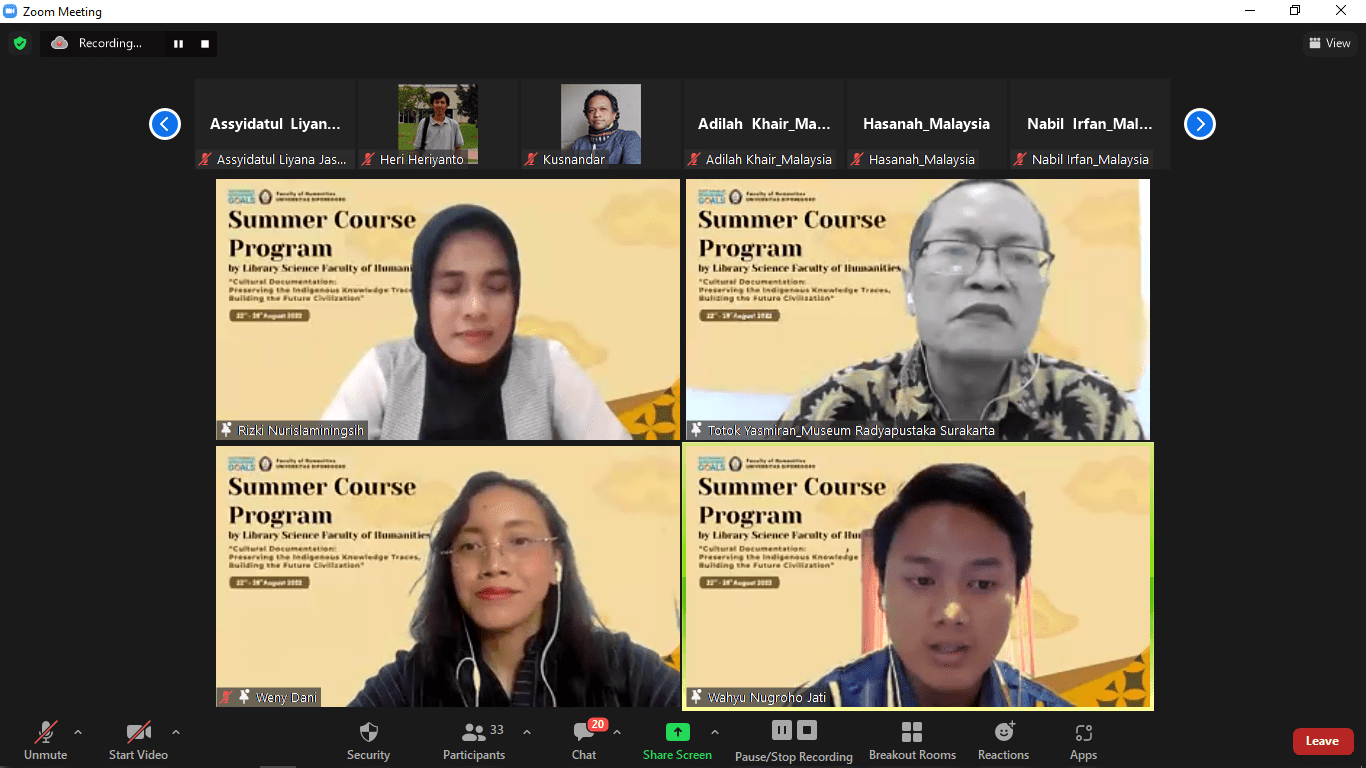The second day of the 2022 Summer Course which was conducted online by the Library Science Study Program, FIB Undip, from August 22 to August 28, 2022, has begun. Participants showed great interest in the course. From a variety of nations, including Malaysia, Pakistan, Turkey, Nigeria, and Indonesia, people took part in these activities.
“Cultural Documentation: Preserving the Indigenous Knowledge Traces, Building the Future Civilization” is the focus of this year’s summer course. On the second day, presented engaging material on the topic of “Reveal in the Indigenous Knowledge Inside the Javanese Manuscript” or “revealing local wisdom in Javanese manuscripts.”
by three speakers. Mr. Kusnandar, S. Sos., M. Si (Ph.D. Candidate-Leiden University). Mrs. Rizki Nurislaminingsih, M.A. (Padjadjaran University) and Mr. Totok Yasmiran, S.S. (Radya Pustaka Museum).
As a lecturer in library science at Padjadjaran University, Mr. Kusnandar, S.Sos, M.Sc., gave the opening remarks at the first session on the second day. He has experience instructing courses on cultural documentation. In his introduction, Mr. Kusnandar discussed local knowledge, the definition of an old script, and the idea that ancient texts are common knowledge.
The Javanese Manuscript, in the speaker’s opinion, is an intellectual creation that exhibits Javanese intellectuality in literature, art, and practice in the form of book objects as a means of appreciation and a representation of living values. In terms of Javanese manuscript examples, there are the Bharatayudha (1814), Serat Babad Mangkunegaran (1800), Fiber Babad Pakubuwana (ca. 1814), Fiber Babad Pakunegara, Fiber Rama Rivet (1814), and so on.
Additionally, Daluang, a thin sheet formed from the bark of the daluang tree or mulberry, is a common type of paper in Indonesia. But Daluang itself is not a type of paper, even if it can be used as a writing surface. Daluang is renowned as a writing surface for old manuscripts because it has the strongest fiber of all the fibers.
Ms. Rizki Nurislaminingsih, M.A, a lecturer in library science at Padjadjaran University and Mr. Totok Yasmiran S.S., a consultant Pawukon from the Radya Pustaka Museum who specializes in philology Also serving as a translator and interpreter is Mrs. Weny Dani delivered the following presentation about Serat Sana Sunu which is a book written by the late R. Ng. Yasadipura II, poet of the Surakarta Hadiningrat Palace in 1819.
Serat Sana Sunu contains teaching and advice for children (teenagers) which is religious. There are 12 chapters in Serat Sana Sunu that people still living should be aware of:
- That God created him as a human
- That he received clothing and food,
- That one must use their own strength in order to get money,
- That people must be Muslims because God has decreed it,
- The Prophet Muhammad claimed.
- Things like interests and clothing
- The process by which people create friends, etc.,
- Items to eat, sleep, stroll, and travel with
- Visitor courtesy,
- It encourages speech and thought.
- Being a huge man or small person is an issue.
- Why are revelation’s standards being lowered and altered?
- must be aware of global movements.
Dhandhanggula, Megatruh, and Sinom, three Javanese songs in the form of Macapat, are used to present this fiber. In the song Dhandhanggula Serat Sana Sunu, there are seven commands and prohibitions for speaking, including being haughty, impolite, gossiping, lying, defaming others, speaking in vain, and making jokes. The words Megat, which means separation, and Ruh, which means spirit, are both found in the hymn Megatruh, which refers to the separation of body and soul. Serat Sana Sunu Megatruh’s moral principles cover how people relate to themselves. When it is Ashar time, it is forbidden for humans to sleep in the afternoon, and the Sinom song discusses a proper sleeping position in accordance with Islamic principles.
Mr. Totok Yasmiran’s tone and voice were imitated by the participants while they sang Javanese songs. The participants appeared excited and seemed to like the music, despite how challenging it was to replicate. The second day of the Summer Course Program concluded with a quick explanation of the songs Dhandanggulo, Megatruh, and Sinom.

